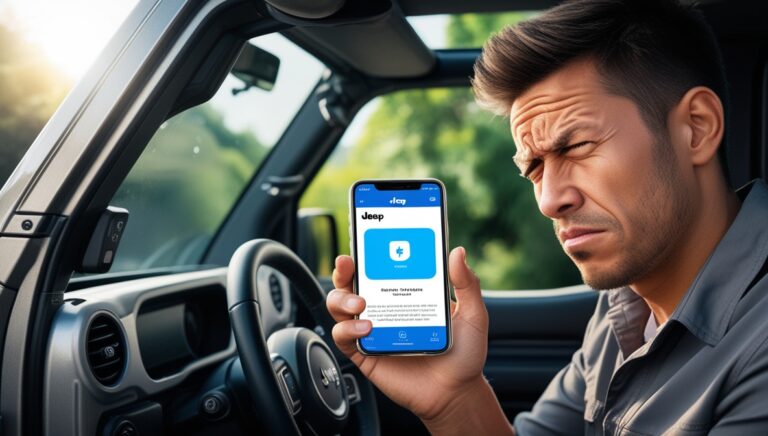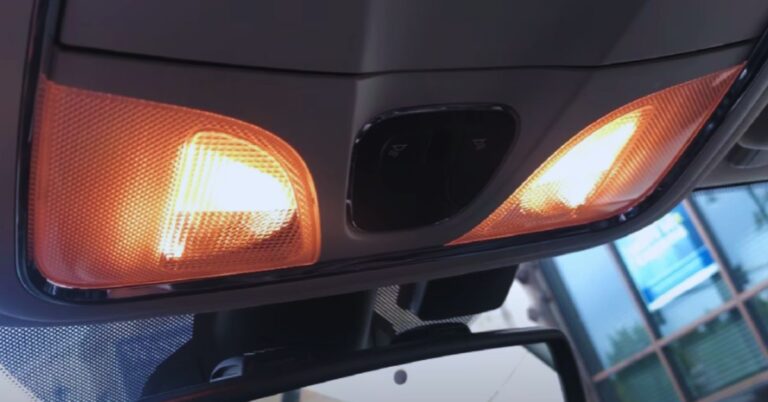ACC/FCW Unavailable Service Required: An In Depth Fixing Guide!
When that ACC/FCW is unavailable, a service required warning appears on your Jeep’s dashboard, it’s like a caution wanting your attention.
It’s telling you something’s not right with two crucial safety features: Adaptive Cruise Control (ACC) and Forward Collision Warning (FCW).
Behind the warning, either it can be due to dirty sensor, software bugs, broken sensor or the electrical issues like blown fuse or loose connection. Even in some cases, just extreme weather triggers the problem.
Regardless of the cause, fixing the problem isn’t a hard task. We’ll comprehensively discuss it here. Just keep on reading.
Key takeaways:
- ACC/FCW Service Required warning indicates that there is issue with the Adaptive Cruise Control (ACC) and Forward Collision Warning (FCW).
- You can fix the issue by identifying the exact cause and taking steps accordingly.
- Regular maintenance can keep you away from this problem.
What Does the “ACC/FCW Unavailable Service Required” Warning Mean?
When your all-terrain drive car displays the warning, it’s alerting you to a potential issue with two important safety features: Adaptive Cruise Control (ACC) and Forward Collision Warning (FCW).
ACC helps maintain a safe following distance by automatically adjusting your car’s speed to match the vehicle ahead, while FCW warns you of imminent collisions with objects or vehicles in your path.
When this warning appears, it means there’s likely a malfunction or issue preventing these systems from operating correctly. It could be due to a number of reasons that we’ll discuss later.
Ignoring the warning may compromise the effectiveness of these safety features, so it’s crucial to have your vehicle as soon as possible.
Reasons And Possible Solution For The Warning
In case your Jeep shows the message, it might mean sensor dirt, electrical faults, or software bugs or many more. But no worries. Here we’ll comprehensively discuss the reason and its possible fixes. Check it out.

1# Dirty sensors
Dirty sensors can definitely cause the Unavailable Service Required warning of the ACC/FCW to pop up in your Jeep. These sensors are crucial for the proper functioning of the Adaptive Cruise Control (ACC) and Forward Collision Warning (FCW) systems.
When they get covered in dirt, grime, or other debris, they can’t accurately detect obstacles or vehicles in front of you. As a result, the systems may be disabled to prevent any potential errors or accidents.
Regularly cleaning these sensors is essential for maintaining their effectiveness. You can do this by gently wiping them with a soft cloth or using a mild cleaner recommended by your vehicle’s manufacturer.
Note: Never use harsh material for cleaning purposes. Use microfiber cloth, warm water, and car shampoo.
2# Windshield issues
Another thing to check is the upper part of your windshield. Sometimes, if it’s dirty or blocked, it can mess with the camera for the FCW system, which sits behind the rearview mirror.
We have seen cases where a dirty windshield caused the issue. Also, if your windshield was replaced with an aftermarket one, it might not have the sight window the camera needs.
So, make sure that area’s clean and clear. If your windshield’s been replaced or if the warning sticks around, might be best to have a mechanic take a look

3# Blown fuse
One common electrical issue that could cause this warning is a blown fuse. Fuses protect various electrical components in your vehicle, including those related to safety features like ACC and FCW.
If a fuse related to these systems blows due to a power surge or other electrical problem, it can disable them and prompt the warning message.
Checking the fuses related to the ACC and FCW systems is relatively straightforward.
You can consult your vehicle’s owner’s manual to locate the fuse box and identify the relevant fuse. If you find a blown fuse, you can replace it with a new one of the same amperage rating.
4# Loose connection
Loose connections within the electrical system can disrupt the flow of power to the sensors and control modules responsible for the ACC and FCW systems.
When connections are loose, intermittent, or corroded, they may fail to deliver the necessary signals or power, causing the systems to malfunction.
This can lead to inaccurate readings or complete disablement of the safety features, triggering the problem you are facing now.
By fixing loose connections or repairing damaged wiring, you can make sure that the sensors and control modules get the signals they need, fixing the problem.

5# Software glitch
The next reason after addressing electrical issues is software glitches. Sometimes, bugs or glitches in the vehicle’s onboard computer systems can cause the ACC and FCW features to malfunction, leading to the problem.
Updating the software or performing a reset may resolve these glitches. You can check if there are any available software updates for your vehicle’s ACC and FCW systems through the manufacturer’s website or by contacting your dealership.
Performing a reset can also help clear any temporary software issues. This typically involves disconnecting the vehicle’s battery for a few minutes and then reconnecting it.
6# Extreme weather
Extreme weather conditions such as heavy rain, fog, or snow can interfere with sensor performance, leading to temporary disablement of the ACC and FCW systems and triggering the warning.
In cases where environmental factors are the culprit, the solution may be as simple as waiting for the weather to clear or adjusting your driving habits to accommodate the conditions.
Once the weather improves or the environmental factors causing interference subside, the ACC and FCW systems should resume normal operation, and the warning message may disappear on its own.
7# Sensor calibration
In Jeeps, just like in any vehicle, the sensors sometimes need a little adjustment to work perfectly. This adjustment process is called sensor calibration. It’s like tuning your car’s senses so they can spot things accurately on the road.
While calibrating sensors usually requires special tools and know-how, some Jeeps have easy ways for you to do it yourself. You might find instructions in your Jeep’s manual or online.
But if you’re not comfortable doing it yourself, no worries! You can always ask a mechanic for a hand.
They have the skills and tools to get the job done right. Calibrating the sensors can often fix the issue without needing lots of complicated work.
8# Brake pads
Problems with the brakes, such as worn brake pads or a malfunctioning brake pedal sensor, can sometimes trigger the message to appear on the screen.
Checking the condition of your vehicle’s brakes is something you can do yourself, although it may require some basic knowledge of automotive maintenance.
You can visually inspect the brake pads for wear and tear, ensuring they have sufficient thickness remaining. Additionally, you can test the brake pedal for proper operation and responsiveness.
9# Battery issues
In some cases, a corroded battery terminal or low or failing battery can trigger warning messages.
You can use a multimeter to measure the voltage of your vehicle’s battery. A healthy battery should have a voltage of around 12.6 volts when the engine is off.
If the voltage is significantly lower than this, it may indicate a weak or failing battery that needs to be replaced.
10# Broken sensor
If a sensor is broken, it can’t function properly, leading to the issue. Sensors play a crucial role in detecting obstacles and vehicles, so if one is damaged or malfunctioning, it can disable the safety features.
Replacing the broken sensor is necessary to restore the functionality of the ACC and FCW systems.

11# Aftermarket modifications.
If your vehicle has undergone aftermarket modifications, such as installing aftermarket sensors or accessories, they may not be compatible with the ACC and FCW systems, leading to malfunctions and warning messages.
Checking for any aftermarket modifications and ensuring they are compatible with the vehicle’s safety systems is essential in troubleshooting this issue.
If you’ve ruled out all other potential causes and the warning persists, consulting with a qualified mechanic or automotive technician to assess any aftermarket modifications is advisable.
Scanner Tool Can Also Help In Diagnosing The Warning
A scanner tool can be instrumental in diagnosing the Unavailable Service Required warning of the ACC/FCW.
These tools can access the jeeps onboard computer system to retrieve diagnostic trouble codes (DTCs) associated with the ACC and FCW systems.
By scanning for DTCs, you can pinpoint specific issues affecting these systems, such as sensor malfunctions or electrical faults. This allows for a more accurate diagnosis and targeted repairs.
However, here are some DTC codes that you may find out for the ACC/FCW system on your jeep.
| DTC codes | What it means |
| C14A5-68 | Camera Blinded |
| C14A5-97 | Camera Blocked |
| P1666 | ACC module fault code |
| C2215 | ACC module fault code |
| C1266 | ACC Sensor Blinded |
| C1266 | Can occur in muddy, icy, or snowy conditions, or if the sensor is misaligned |
Why Should You Fix The Problem Early?
Fixing the problem early is crucial for several reasons.
- Firstly, these systems enhance driving safety by providing advanced collision avoidance features. Delayed repairs can compromise vehicle safety, increasing the risk of accidents.
- Secondly, unresolved issues may lead to further damage or malfunctions in related components, potentially resulting in more extensive and costly repairs.
- Additionally, addressing the problem promptly ensures optimal vehicle performance and functionality, preserving the value and longevity of your Jeep.
By taking proactive measures to resolve the warning early, you prioritize safety, minimize potential risks, and maintain the reliability of your vehicle.
Tips For Jeep ACC/FCW System Maintenance
Well here are some tips that you can follow for maintaining the ACC/FCW system of your jeep.
- Keep the sensors and camera lenses clean from dirt, debris, and obstructions to ensure optimal performance.
- Periodically inspect the sensors, camera lenses, and other components for any signs of damage, wear, or corrosion.
- Adhere to the manufacturer’s recommended maintenance schedule for your vehicle, including sensor calibration and software updates.
- Avoid aftermarket modifications that could interfere with the ACC/FCW system’s operation or compromise its effectiveness.
- Maintain a safe following distance, avoid tailgating, and stay attentive while driving to reduce the likelihood of relying solely on the ACC/FCW system.
FAQs
At this point of the discussion, let’s check out some queries that are mostly asked by the jeep owners about the ACC/FCW system. We hope it will help you more.
Where is the ACC FCW sensor?
The ACC/FCW sensor is typically located behind the rearview mirror, mounted on the windshield. It uses cameras and sensors to detect vehicles and obstacles ahead, enabling features like adaptive cruise control and forward collision warning.
What does FCW unavailable mean?
“FCW Unavailable” means the Forward Collision Warning system is not operational, possibly due to sensor obstruction, electrical issues, or software glitches. It’s essential to address the problem promptly for safety.
What does ACC sensor block mean?
“ACC Sensor Blocked” indicates an obstruction affecting the Adaptive Cruise Control system’s sensors, hindering its ability to maintain a safe distance from vehicles ahead. Clearing the obstruction or cleaning the sensor may resolve the issue.
Final Words
In conclusion, understanding and addressing the problem in your Jeep is crucial for maintaining safety and functionality on the road.
By identifying potential causes such as dirty sensors, electrical faults, or software glitches, and implementing appropriate solutions, you can ensure the proper operation of these critical safety features.
Regular maintenance can help to provide a safer driving experience and help preserve the longevity of your vehicle.
Remember to consult professional help when needed. Stay informed, stay safe, and enjoy your Jeep journey to the fullest.




